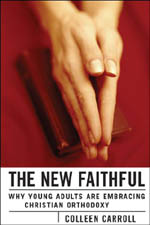 (Reprinted with permission from The Wall Street Journal ©2002 Dow Jones & Company, Inc. All rights reserved.)
(Reprinted with permission from The Wall Street Journal ©2002 Dow Jones & Company, Inc. All rights reserved.)
In 1993, 24-year-old David Legge seemed to have the world by the tail. Blessed with Tom Cruise-ish good looks, he had just finished his second year at Yale Law School and was a summer associate at a big New York law firm.
Making more money than he could spend, he painted the town red four or five nights a week. There was only one problem. He wasn't happy.
"I had a good time, I guess," Legge recalls, "but I didn't have that many real friends in New York. And I realized that it was just kind of an empty life."
Like many Gen X (and Y) Catholics raised in the wake of the reforms of the Second Vatican Council, Legge's childhood religious formation had been spotty at best. He was raised in a Catholic family, but he found that his religious courses in school consisted mostly of "psychobabble." The spiritual emptiness he was feeling that summer in New York led him to apply to his own faith the kind of intensity he had previously reserved for his legal studies. The result was a revelation. "It was like God hit me over the head with a bottle," he said. It took a few years, but eventually Legge found the courage to walk away from his job and the girlfriend who did not share his deepening Catholic faith and enter a Dominican seminary to become a priest. David Legge's conversion (or re-conversion) story is one of many that animate the pages of Colleen Carroll's The New Faithful. A reporter for the St. Louis Post-Dispatch, Carroll combines first-hand reporting with social-science metrics to examine a remarkable trend toward religious orthodoxy among Americans born roughly between 1960 and 1983. These were the children exposed full-force to the consumerism, secularism and "me-first" ideology that seized the helm of American society in that period -- very much including most mainstream religious denominations.
Concentrating her reporting on Catholics and evangelical Protestants, Carroll borrows G.K. Chesterton's definition of "orthodoxy" as the Apostles' Creed. ("I believe in God the Father Almighty, Maker of heaven and earth . . ."). For the young adults profiled in her book, that means the acceptance of a transcendent moral authority, a commitment to regular prayer and worship, a belief in absolute truth and an allegiance to objective standards of conduct. What drives these young people in such a, well, unorthodox direction? The high rate of divorce among Baby-Boomer parents certainly played its role. And anyone with the least experience of young people knows that a high percentage of them, almost by reflex, are skeptical of the dogmas laid down by their elders. That seems just as true when the dogmas are relativism, permissiveness and militant secularism as when they are their opposites. The appeal of Pope John Paul II to young people, evident from the first days of his pontificate, is mentioned frequently by Catholics and Protestants alike.
The orthodoxy vogue, if it may be called that, does not please everyone. Some baby-boomer priests actually seem bitter about it -- or envious. After all, new and orthodox religious orders like the New York-based Sisters of Life and the Franciscan Friars of the Renewal are turning away candidates while liberal orders wither on the vine.
"There's a kind of nostalgia for a church they've never experienced -- and I have," one priest grouses. "I don't want to go back there." But the young orthodox faithful are not looking back. They are looking forward, striving to make something "countercultural" in the non-1960s sense of the word. Thus they are eager to evangelize their peers. That their peers often remain unaffected doesn't discourage them, either. You don't need to convert a whole generation, one of Carroll's subjects points out. Jesus, after all, started with just twelve.